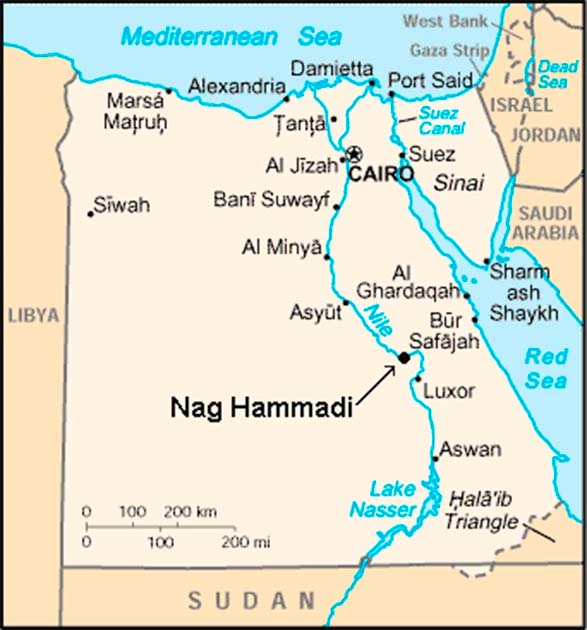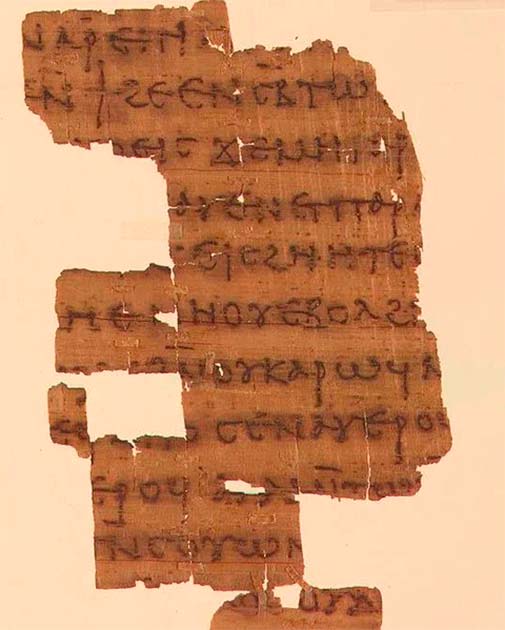The Nag Hammadi Library is a collection of Gnostic and early Christian texts that were discovered in Northern Egypt in the town of Nag Hammadi in 1945. They are also known as the Gnostic Gospels or the Chenoboskion Manuscripts.
Thirteen leather-bound papyrus codices were found in a sealed jar by a local farmer named Muhammed al-Samman. These texts were made up of 52 treatises as well as three works belonging to the Corpus Hermeticum and a small translation of Plato’s Republic.
It was these discoveries that significantly influenced scholars’ knowledge and pursuit of Gnosticism and Christianity in the ancient world. Here, it seemed, was an entirely separate branch of early Christianity.
Within the codices, the texts are written in the Coptic Language which is a form of Egyptian script. The best known is probably the Gospel of Thomas which the Nag Hammadi contains the only complete text.
Scholars have recognized that fragments of sayings attributed to Jesus appeared in the manuscripts discovered at Oxyrhynchus in 1898 as well as in the Nag Hammadi. These manuscripts are now housed in the Coptic Museum in Cairo. But what was in the library and how were they discovered?
Discovery
In 1945, a group of Egyptians that were digging for fertilizer stumbled across Nag Hammadi. They were at the base of the Jabal al-Tarif located on the east bank of the Nile and across the river from the town of Nag Hammadi.

The farmer broke the jar that they found and discovered thirteen leather-bound codices. He took them home and his mother used some of the pages for fuel on the home oven, thinking them valueless.
The codices were however quickly passed into the hands of various antique dealers. Importantly, it ended up in the Jung Institute in Zurich before being moved to the Coptic Museum in Old Cairo where it went through preservation and has been sustained ever since.
- The Derveni Papyrus: the Oldest Book in Europe?
- The Hidden Text of the Sanaa Manuscript: A Prototype Quran?
Despite the hoard of manuscripts being referred to as a “library”, researchers have no definite evidence that they were created with a larger collection in mind. The scripts, writing styles and materials, and dialects are all varied and diverse.
There have been estimates made that suggest there were at a minimum 14 different scribes throughout the texts. Although they are all written in the Coptic language, some of the texts are similar to a more Sahidic dialect whilst others are closer to the Subakhmimic. As well as this, there are huge variations between these two quite similar scripts.
It is likely that the manuscripts were copied in various locations and collated later on by a group or individual. In Addition to their insight into the history of religions, the texts have reinvigorated the study of Coptic philology and codicology.
Many of the leather covers of the texts contain scraps of discarded papyrus glued together in order to make the cover more firm. The latest of the scraps can be dated to 348 AD. This suggests that these codices were made sometime around 350 AD and buried in the following decades.
There has been a long debate about who may have copied the manuscripts, collated them, and buried them. Some have suggested that it was Christian monks perhaps afraid of persecution. The discovery was made near the ancient site of Pbou and some of the manuscript covers contain letters from monks from that era.
However, Christian monks were not the only ones interested in preserving religious texts in fourth-century Egypt. Thus, it cannot be proved who decided to keep these texts safe for future generations.
It has even been speculated that the Bishop of Athanasius of Alexandria’s declaration of the Bible for the Egyptian church in a letter of 367 may have led to the burial of the codices. However, there is nothing to confirm or deny these theories.
Gnosticism: Hidden Knowledge?
There are forty-six different treatises contained in the codices which have diverse content in genres and theologies. Most of the religious texts can be categorized as Jewish or Christian as they seem to be derived from the Hebrew Bible.
- The Edwin Smith Papyrus: Practical Egyptian Medicine
- Why was the Infancy Gospel of Thomas Excluded from the Bible?
However, there are also aspects of the manuscripts that don’t come from this for example the parts that detail Plato’s Republic. The texts were originally composed in Greek before being translated into Coptic. This makes it difficult to trace the origins of the manuscripts.
Much of the content discussed in the manuscripts covers apocalypses and revelations. These usually include a divine figure or an authoritative mortal that reveals the future, theological ideas, or cosmological secrets.
Despite many of the texts referring to themselves as Gospels, none of them resemble the Gospels of the New Testament that are present today. For example, the Gospel of Thomas seems to just be a collation of Jesus’s sayings without any narrative to guide them along.

The discovery of Nag Hammadi has had a huge impact on various areas of the religious history of the Mediterranean ancient world. This is true despite the results not being completely clear as of yet. Scholars have spent decades editing and translating the tracts and are still trying to work out how the new data impacts fields such as the New Testament, Gnosticism, and the traditions of Jesus.
Before the discovery, only a handful of published works existed for Gnosticism written in the Coptic script. Scholars can now read work in Coptic translations, works produced by Gnostics themselves rather than rely on accounts from their opponents.
These accounts often included cliched charges and attacks on Gnostics. However, despite the discovery, scholars have been unable to identify a definite description of the Gnostic faith and how people became indoctrinated into Gnosticism.
Even though they have been impressed by the variety of texts, some scholars have come to the conclusion that the study of these texts should be abandoned. The codices have provided a new line of inquiry for scholars of the ancient Mediterranean world, but they have provided very few answers.
The study of early church history in this period remains as murky as it ever was before their discovery.
Top Image: The Nag Hammadi library allowed scholars to read about gnostic Christianity in their own words. Source: geralt / Public Domain.
By Kurt Readman